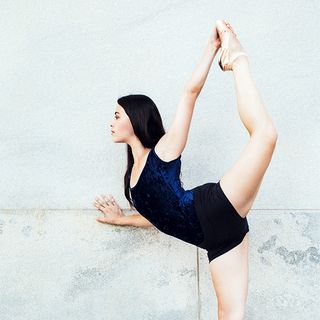7 Ways NYC Ballerinas Deal With Stress, Competition, and Rejection

To compare one job to another in terms of stress, competition, and rejection is all really relative; there are valid arguments that standards, no matter how different, are high across all industries. But there's a sense these things are magnified in the world of ballet.
We can partially blame this on pop culture tropes that we've seen over and over again: The pitting of two dancers who are vying for the same part against each other and the overachieving, too-dedicated dancer who will do anything to achieve his or her dream no matter the cost are common TV and movie plots. The numbers on dancers also don't really help. According to the Bureau of Labor Statistics, there are 10,060 professional dancers in the United States as of 2016; 4220 of those are in performing art companies. Such limited spots automatically make the competition more intense.
But while it makes for a great drama to fantasize a cutthroat world where dancers are constantly sabotaging each other's chances just to get the top spot, in reality, it couldn't be further from the truth. We spoke with New York City Ballet corps dancer Kristen Segin and soloist Brittany Pollack about how they deal with stress, competition, and rejection in such high-pressure situations. Scroll down to see what they had to say.

Kristen Segin, New York City Ballet Corps Dancer
"I rely heavily on my friends and colleagues at the ballet," says Kristen Segin. "They lift me up when I'm feeling down, and we make sure to keep each other laughing."
Segin is part of the corps de ballet, which, according to Ballet Hub, is a classical ballet term that means dancers who are not the soloist or principal dancers but make up the body of the dance by dancing together as a group. These dancers must work well together as a team, so unison is key. "We are constantly working together as a team to present the audience with something beautiful," she says. "It feels like a family.
Although it is very competitive to get these coveted spots, she insists that it is a common misconception that dancers are catty and are looking for ways to sabotage each other. "Although there is some healthy competition, for the most part, we work well together and support each other like a sports team," she says.
As for dealing with the stress of auditioning for a role or being anxious before a big performance, she says she likes to find the quiet among the chaos.
"I have been dancing with New York City Ballet for almost 10 years now, but I definitely still get nervous," she says. "I find that taking a quiet moment to think about my breathing helps me calm my nerves before a show."
Her most important piece advice for handling rejection? "Always work hard and stay positive," she says.

Brittany Pollack, New York City Ballet Soloist
When things are extremely stressful, it's always helpful remembering why you're putting yourself through all these hardships: At the end of the day, you're doing something that you love. "I always remember how dancing makes me feel," says Brittany Pollack. "That is all I need to stay positive and keep going."
Pollack is a soloist, which, according to an article on ThoughtCo., means that she dances solos in productions and oftentimes serves as an understudy to the principal dancer. According to her, it serves no purpose to be mean or standoffish with one another. "Ballerinas are all in the same boat," she says. "We root each other on and support each other as much as possible."
Whereas Segin likes to find a quiet space to calm down nerves and de-stress, Pollack likes to keep her energy up. "I like to listen to music in the dressing room with my girlfriends and dog," she says. "It's the best way to keep me calm and collected before a big performance."
While rejection does come with being a ballet dancer, she believes it is important to focus on yourself to keep going. "Do not compare yourself to others. Every ballerina has her own strengths and weaknesses," she says. "Play to your strengths, recognize your weaknesses, and always keep smiling."
So take movies like Black Swan (one of my favorite films, ICYWW) just for their entertainment value. Rest assured that when you're watching a production of your favorite ballet, the women and men up there dancing are doing what they love with the support of their company.
Disclaimer
This article is provided for informational purposes only and is not intended to be used in the place of advice of your physician or other medical professionals. You should always consult with your doctor or healthcare provider first with any health-related questions.

Kate Moss. She's the OG beauty chameleon.
Who are your 5 favorite people to follow on Instagram?@zoeisabellakravitz @bellahadid @emrata @beautifuldestinations @bookofthemonth
What's the beauty essential you can’t live without?Eyeliner. People sadly look at me strangely (or share concern over my well being) when I don't wear it. My go-to is the Marc Jacobs Beauty Highliner Gel Eye Crayon Eyeliner in black.
What's your desert island album?The Weeknd's Starboy.
What's your favorite Byrdie.com story?Game of Thrones Star Nathalie Emmanuel on Fame, Fear, and Her Iconic Hair. It's such a great profile on her and it almost made me want to start watching Game of Thrones.

